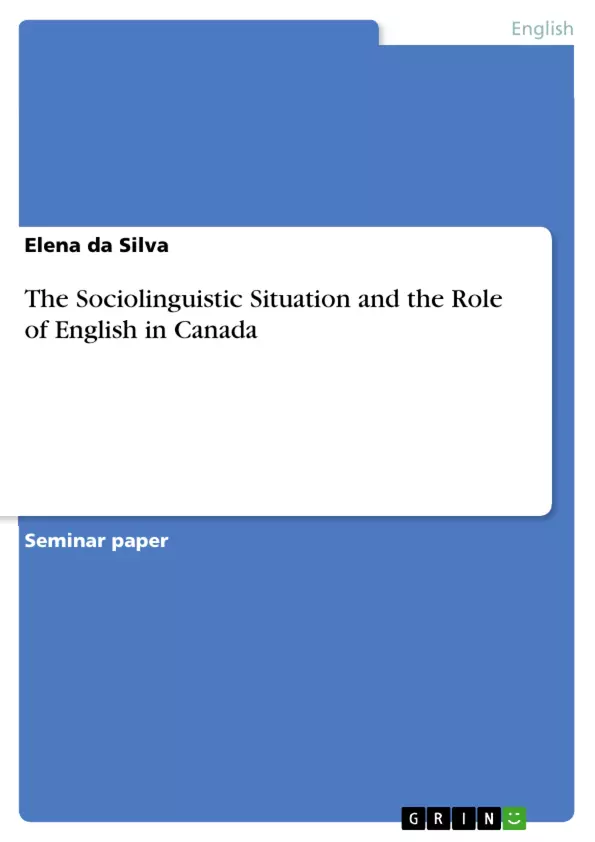English is the leading language of international discourse, mainstream media and is spoken in. It is the official language of 67 countries total, the most known ones being the US, the United Kingdom, Australia and of course Canada.
This term paper will discuss the English spoken in Canada, elucidate its role in the country and inform about the sociolinguistic situation. It will also pay attention to some of the other languages that have been and are currently spoken in Canada, with the main in this focus being on French. Since this term paper does not pursue an actual research question, it will summarize the most important historical events and (socio-)linguistic facts and features.
The purpose is to give a general overview over the English spoken in Canada and to create a better understanding of Canadians mentality, the relationships between the different provinces and the linguistic differences it has to its neighbor – the US.
To do so, this term paper is apportioned into three major points – the origin and history of English in Canada, the most prominent linguistic features as well as the sociolinguistic situation. The first chapter will provide a general overview over the (re-)discovery of Canada by the French and British, illustrate the historical chronology as well as explain why certain provinces have certain official languages.
In the second chapter, this term paper takes a look at the most distinctive linguistic features. What are the similarities to American or British English, what distinguishes US-American and British English from Canadian English and what is exclusive to the English spoken in Canada?
The third and final chapter is less theoretical. It will tell the reader more about the life in Canada. It designates the languages that have been and are currently spoken in the country and offers some insight into the Educational System as well as the land of media in Canada.
Inhaltsverzeichnis (Table of Contents)
- Introduction
- The European Rediscovery of Canada
- Origin of English in Canada
- History of English in Canada
- Linguistic Features
- Grammar and Spelling
- Vocabulary and Canadianisms
- Pronunciation
- Sociolinguistics
- Indigenous Languages
- French in Canada
- School
- Media
- Conclusion
Zielsetzung und Themenschwerpunkte (Objectives and Key Themes)
This term paper focuses on the English spoken in Canada, exploring its role in the country and examining the sociolinguistic situation. It aims to provide a comprehensive overview of the language's historical development, key linguistic features, and its interaction with other languages spoken in Canada. The paper also explores the cultural and social contexts that have shaped the development of English in Canada.
- The historical development of English in Canada, from its initial introduction to its current status as one of the official languages.
- The distinctive linguistic features of Canadian English, including its similarities and differences to other varieties of English.
- The sociolinguistic landscape of Canada, encompassing the influence of indigenous languages, French, and the role of education and media.
- The relationship between English and other languages in Canada, highlighting the cultural and social dynamics involved.
- The impact of immigration and multiculturalism on the evolution of English in Canada.
Zusammenfassung der Kapitel (Chapter Summaries)
The first chapter delves into the European rediscovery of Canada, starting with Jacques Cartier's arrival in 1535. It traces the establishment of French settlements and the subsequent arrival of British colonizers in the early 17th century. The chapter highlights the historical events that shaped the early development of English in Canada, including the British Proclamation of Independence in 1763 and the resulting political tension. The second chapter examines the distinct linguistic features of Canadian English. It explores the similarities and differences to American and British English, identifying the unique characteristics that set Canadian English apart. The chapter also examines the impact of Canadianisms, regional variations, and the ongoing evolution of the language. The third chapter focuses on the sociolinguistic situation in Canada. It examines the historical and contemporary role of indigenous languages, exploring their influence on the development of Canadian English. It further investigates the significant presence of French in Canada, exploring the sociolinguistic dynamics and tensions surrounding the country's bilingualism. The chapter also delves into the role of education and media in shaping the language landscape of Canada.
Schlüsselwörter (Keywords)
Canadian English, sociolinguistics, language history, linguistic features, indigenous languages, French in Canada, bilingualism, multiculturalism, education, media, historical development.
- Citation du texte
- Elena da Silva (Auteur), 2021, The Sociolinguistic Situation and the Role of English in Canada, Munich, GRIN Verlag, https://www.grin.com/document/1158031



